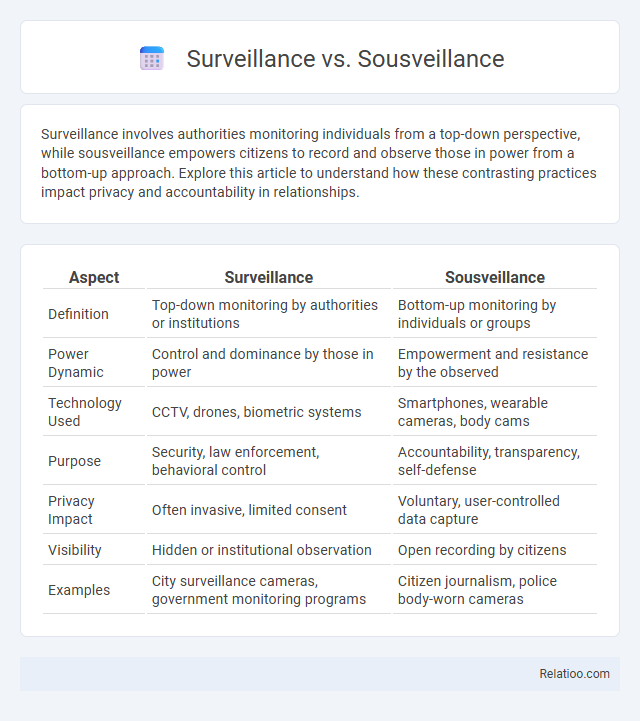Surveillance involves authorities monitoring individuals from a top-down perspective, while sousveillance empowers citizens to record and observe those in power from a bottom-up approach. Explore this article to understand how these contrasting practices impact privacy and accountability in relationships.
Table of Comparison
| Aspect | Surveillance | Sousveillance |
|---|---|---|
| Definition | Top-down monitoring by authorities or institutions | Bottom-up monitoring by individuals or groups |
| Power Dynamic | Control and dominance by those in power | Empowerment and resistance by the observed |
| Technology Used | CCTV, drones, biometric systems | Smartphones, wearable cameras, body cams |
| Purpose | Security, law enforcement, behavioral control | Accountability, transparency, self-defense |
| Privacy Impact | Often invasive, limited consent | Voluntary, user-controlled data capture |
| Visibility | Hidden or institutional observation | Open recording by citizens |
| Examples | City surveillance cameras, government monitoring programs | Citizen journalism, police body-worn cameras |
Defining Surveillance and Sousveillance
Surveillance is the systematic monitoring of behavior, activities, or information for the purpose of influencing, managing, or protecting, typically conducted by authorities or organizations using technologies like CCTV cameras and data analytics. Sousveillance refers to the recording or monitoring of an environment by individuals, often through wearable devices or smartphones, aiming to provide transparency and accountability from a grassroots perspective. The distinction lies in the power dynamics where surveillance represents top-down observation, while sousveillance embodies bottom-up, citizen-led documentation.
Historical Evolution of Surveillance
Surveillance has evolved from ancient methods like watchtowers and town criers to sophisticated digital monitoring systems powered by AI and big data, reflecting increasing societal emphasis on security and control. The advent of sousveillance--individuals recording authorities using wearable technology--emerged as a counterbalance to traditional surveillance, empowering citizens with greater transparency. Your understanding of this historical evolution highlights the dynamic tension between centralized observation and personal accountability in modern surveillance practices.
The Rise of Sousveillance Technologies
Sousveillance technologies have surged as wearable devices and smartphones empower individuals to record and monitor their surroundings, shifting control from centralized surveillance systems to the public. This rise democratizes accountability by enabling citizens to capture police conduct, corporate practices, and social interactions, challenging traditional top-down voyeuristic power dynamics. Enhanced by advances in cloud storage and real-time streaming, sousveillance fosters transparency and can act as a counterbalance to institutional surveillance.
Key Differences Between Surveillance and Sousveillance
Surveillance involves monitoring individuals or groups by authorities using cameras, sensors, or software to gather data for security or control purposes. Sousveillance refers to the act of individuals recording or monitoring those in power, often with wearable devices or smartphones, promoting accountability from the bottom up. Your understanding of these key differences highlights surveillance as a top-down process, whereas sousveillance empowers people to observe those in authority, balancing power dynamics through reciprocal observation.
Social Impacts of Surveillance
Surveillance involves monitoring by authorities or organizations, often leading to power imbalances and concerns over privacy erosion in society. Sousveillance, where individuals record those in power, can empower communities and increase accountability but may also raise issues of mistrust and data misuse. Your awareness of these dynamics is crucial for navigating the social implications of pervasive surveillance technologies in everyday life.
Empowerment Through Sousveillance
Sousveillance shifts the power dynamic by enabling individuals to capture and monitor activities from their own perspective, using wearable cameras or smartphones, thus fostering personal empowerment and accountability. Unlike traditional surveillance, which primarily serves institutional or governmental oversight, sousveillance democratizes observation, giving you the tools to document interactions and challenge abuses. This empowerment through sousveillance enhances transparency, supports citizen journalism, and strengthens community vigilance in ways conventional surveillance cannot achieve.
Privacy Concerns in a Watchful Society
Surveillance involves top-down monitoring by authorities or organizations, raising concerns about mass data collection and potential abuses of power compromising individual privacy. Sousveillance, characterized by individuals recording those in authority, challenges traditional surveillance by promoting transparency but introduces risks of unauthorized data sharing and consent violations. Balancing these practices in a watchful society requires robust privacy protections, clear legal frameworks, and technologies that empower personal control over recorded data.
Legal and Ethical Considerations
Surveillance involves top-down monitoring typically by governments or organizations, raising legal issues such as privacy rights, data protection laws, and potential misuse of power, whereas sousveillance, or bottom-up monitoring by individuals, challenges conventional legal frameworks by emphasizing transparency and accountability. Ethical considerations for surveillance highlight concerns about mass data collection, consent, and the balance between security and individual freedoms, while sousveillance promotes empowerment but risks privacy violations and misuse of recorded information. Legal systems must navigate the complex interplay between protecting civil liberties and enabling oversight through both surveillance and sousveillance practices.
Real-World Examples and Case Studies
Surveillance, characterized by top-down monitoring such as CCTV in public spaces, serves law enforcement and corporate security by deterring crime and ensuring safety. Sousveillance, exemplified by citizens using body cameras or smartphones to record police interactions, empowers individuals to hold authorities accountable and promote transparency. Real-world case studies include London's CCTV network reducing crime rates, while sousveillance instances like the George Floyd incident highlight how citizen recordings influence social justice and policy reforms, demonstrating how Your active role can shift power dynamics.
The Future of Observation: Balancing Power
Surveillance involves top-down monitoring by authorities, often leading to power imbalances, while sousveillance refers to bottom-up observation by individuals, promoting accountability and transparency. The future of observation hinges on integrating both practices to balance control and empowerment, leveraging technologies like AI and blockchain for secure, ethical data management. Achieving this equilibrium requires frameworks that protect privacy, ensure consent, and enable participatory observation in diverse societal contexts.

Infographic: Surveillance vs Sousveillance
 relatioo.com
relatioo.com